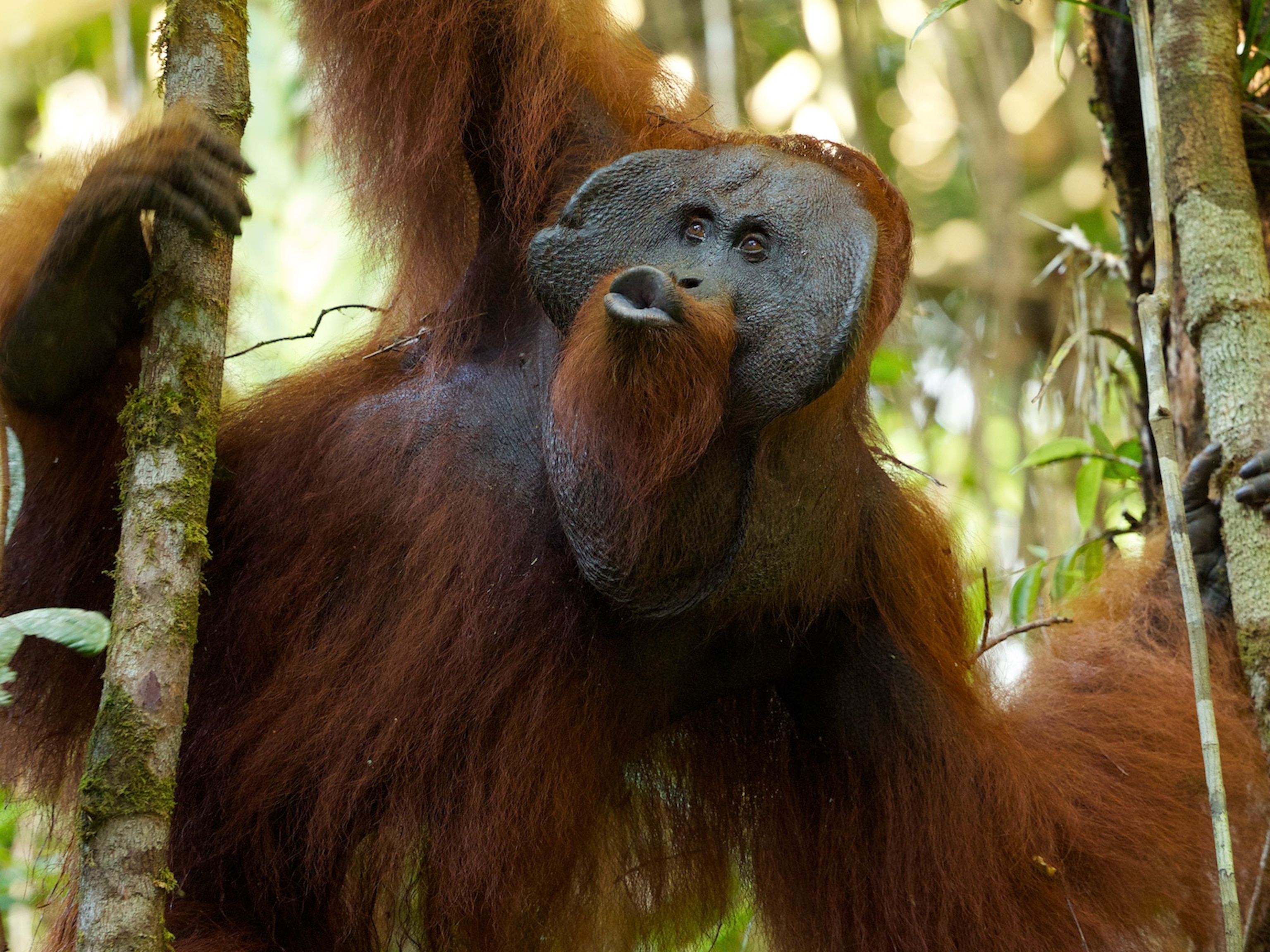
Postcards From Borneo: The Best Swimming Hole in Gunung Palung
I dove into the freezing water with a splash, and a chill swept through my body. As I resurfaced I saw the tall, thundering waterfall up ahead, roaring like a lion. We had gone to the waterfall because it was one of those days when there were no orangutans around to follow. My brother, Russell, and I love to swim in the river in our free time. We have lots of good swimming spots near camp, but the better ones are higher up on the river. The best swimming hole of all is the waterfall. Unfortunately, it is also the farthest away. It is a relief when you hear the rumbling of the waterfall because you know you are getting close.
WATCH: Jessica and Russell Laman make a video of their hike to a waterfall in Gunung Palung.
But one advantage of taking a hike through the jungle is that we get a chance to see a few of the other animals in the forest, including macaques, red leaf monkeys, and gibbons. When the red leaf monkeys cross the river you can get a good view of their bright orange bodies and long tails. The macaques are also pretty easy to see. They like to hang out in some of the trees around camp.

LISTEN: White-bearded gibbons call from the trees.
The least common primates are gibbons. They have dark gray bodies with white splotches around their eyes that remind me of goggles. They also have a tuft of white beard, so they are called the white-bearded gibbons. Their legs are short, but their arms are so long that if you stood them on the floor their hands would touch the ground. They swing between branches like Olympic gymnasts and are so nimble and quick that they are rarely seen. When we do see them, we usually only glimpse them for a few seconds, but we hear them every morning. They wake us up with their long calls echoing through the forest for a mile around, like the jungle version of a rooster.
As we descend the last hill to the waterfall I hear another one of the coolest animals of the rainforest: the hornbills. We can hear the beat of their wings as they soar over the canopy, their calls ringing through the trees. Although we don’t see them often, we had really good luck this year: We found two nests, which like all hornbill nests, were built in tree cavities. We got a great view of a nest belonging to a family of bushy-crested hornbills as the dad flew back and forth transporting food. Since the mother bird was inside the nest, sometimes we could see her beak stick out to grasp the insects or fruit that had been brought to the hole.

Finally, we wade across the river and up the slippery rocks, and arrive at the edge of the waterfall pool. A little further and I am right in front of the roaring waterfall. As the droplets of water hit the pool below, some of them bounce off the surface like beads on a tabletop, sending water flying in all directions. I take a big breath and dive underneath the waterfall. I feel the water pounding on my back and head, like someone pounding me with their fists, and with one final kick I am in the space behind the waterfall! I have to stick my toes into notches in the rock to make my head stay above water, but it’s cool to be able to look up and see the water pouring down in front of me. The noise is deafening and if someone else is behind the waterfall with me, we have to scream in order to hear each other.
Gunung Palung is full of lots of fun things to do.

Over the past weeks, Proof has been following the adventures of Tim, Cheryl, and their children, 10-year-old Jessica and 14-year-old Russell, in the rain forests of Borneo. Tim’s story on orangutan behavior will be featured in an upcoming issue of National Geographic. Cheryl is a 2004 Emerging Explorer and has received grants from the National Geographic Society for her work with orangutans.
Related story: A Family Adventure Begins Anew
Related story: The Boat Trip Up River
Related story: Chasing Orangutans
Related Story: The World’s Stinkiest (But Best) Fruit
Related Topics
You May Also Like
Go Further
Animals
- This ‘saber-toothed’ salmon wasn’t quite what we thoughtThis ‘saber-toothed’ salmon wasn’t quite what we thought
- Why this rhino-zebra friendship makes perfect senseWhy this rhino-zebra friendship makes perfect sense
- When did bioluminescence evolve? It’s older than we thought.When did bioluminescence evolve? It’s older than we thought.
- Soy, skim … spider. Are any of these technically milk?Soy, skim … spider. Are any of these technically milk?
- This pristine piece of the Amazon shows nature’s resilienceThis pristine piece of the Amazon shows nature’s resilience
Environment
- This pristine piece of the Amazon shows nature’s resilienceThis pristine piece of the Amazon shows nature’s resilience
- Listen to 30 years of climate change transformed into haunting musicListen to 30 years of climate change transformed into haunting music
- This ancient society tried to stop El Niño—with child sacrificeThis ancient society tried to stop El Niño—with child sacrifice
- U.S. plans to clean its drinking water. What does that mean?U.S. plans to clean its drinking water. What does that mean?
History & Culture
- Séances at the White House? Why these first ladies turned to the occultSéances at the White House? Why these first ladies turned to the occult
- Gambling is everywhere now. When is that a problem?Gambling is everywhere now. When is that a problem?
- Beauty is pain—at least it was in 17th-century SpainBeauty is pain—at least it was in 17th-century Spain
- The real spies who inspired ‘The Ministry of Ungentlemanly Warfare’The real spies who inspired ‘The Ministry of Ungentlemanly Warfare’
- Heard of Zoroastrianism? The religion still has fervent followersHeard of Zoroastrianism? The religion still has fervent followers
Science
- Here's how astronomers found one of the rarest phenomenons in spaceHere's how astronomers found one of the rarest phenomenons in space
- Not an extrovert or introvert? There’s a word for that.Not an extrovert or introvert? There’s a word for that.
- NASA has a plan to clean up space junk—but is going green enough?NASA has a plan to clean up space junk—but is going green enough?
- Soy, skim … spider. Are any of these technically milk?Soy, skim … spider. Are any of these technically milk?
- Can aspirin help protect against colorectal cancers?Can aspirin help protect against colorectal cancers?
Travel
- What it's like to hike the Camino del Mayab in MexicoWhat it's like to hike the Camino del Mayab in Mexico
- Is this small English town Yorkshire's culinary capital?Is this small English town Yorkshire's culinary capital?
- This chef is taking Indian cuisine in a bold new directionThis chef is taking Indian cuisine in a bold new direction
- Follow in the footsteps of Robin Hood in Sherwood ForestFollow in the footsteps of Robin Hood in Sherwood Forest




